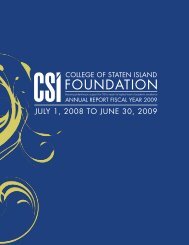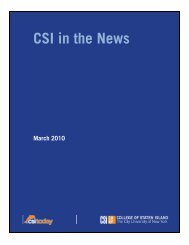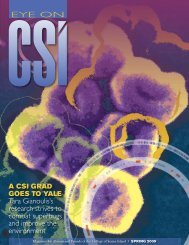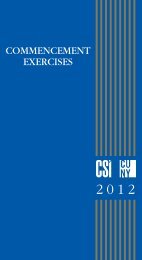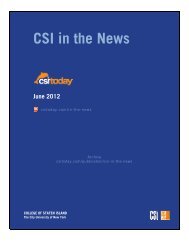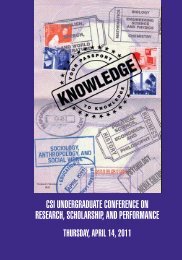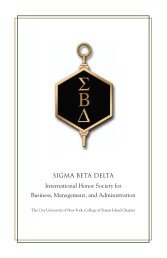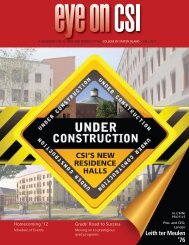CSI in the News - CSI Today
CSI in the News - CSI Today
CSI in the News - CSI Today
- No tags were found...
Create successful ePaper yourself
Turn your PDF publications into a flip-book with our unique Google optimized e-Paper software.
“These are irreplaceable national treasurers because we’re not go<strong>in</strong>g back to <strong>the</strong> moon any time soon,” saidMs. Kratz <strong>in</strong> respect of lunar rocks made up of exotic-sound<strong>in</strong>g Orange Soil, Highlands Soil, Mare Soil,Breccia and Anorthosite. “This is space exploration for a new generation because today’s kids haven’texperienced <strong>the</strong> excitement <strong>in</strong> <strong>the</strong> same way as ano<strong>the</strong>r generation had dur<strong>in</strong>g Apollo.”But <strong>the</strong> most excit<strong>in</strong>g chapter of space exploration, could be <strong>in</strong> <strong>the</strong> future, said Professor Irv<strong>in</strong>g Robb<strong>in</strong>s,director of <strong>the</strong> astrophysical observatory at <strong>the</strong> College of Staten Island, who will give a multimediapresentation Monday for all ages that he has dubbed “The Good, <strong>the</strong> Bad and <strong>the</strong> Ugly of Asteroids andComets.”The chips of meteorites on display <strong>the</strong> Center, some of which came from chunks of spacerock that fell toearth <strong>in</strong> Mexico <strong>in</strong> 1969, conta<strong>in</strong> m<strong>in</strong>erals <strong>in</strong>creas<strong>in</strong>gly difficult or impossible to f<strong>in</strong>d on Earth.“There is a tremendous amount of wealth out <strong>in</strong> <strong>the</strong> Astrobelt,” said Robb<strong>in</strong>s, describ<strong>in</strong>g a place <strong>in</strong> spacebetween Mars and Jupiter with millions of asteroids — “chunky little bodies,” some of which are 1,000 milesacross. “I’m go<strong>in</strong>g to be speak<strong>in</strong>g about one value, awareness: There is a bigger universe than just StatenIsland.”Energy-starved earthl<strong>in</strong>gs should look to comets for hydrocarbons, ammonia and methane for fuel, and <strong>the</strong>organic compounds <strong>in</strong>tegral to fertilizer and syn<strong>the</strong>tic gasol<strong>in</strong>e, Robb<strong>in</strong>s said.“So when <strong>the</strong> price of gas is $50 a gallon, <strong>the</strong>re are resources wait<strong>in</strong>g for us out <strong>the</strong>re,” said Robb<strong>in</strong>s. “If wedon’t exploit <strong>the</strong>m, we’re go<strong>in</strong>g back to <strong>the</strong> stone age. The future of humanity is <strong>in</strong> space.”After Robb<strong>in</strong>s speaks from 1 to 2 p.m. on Monday, his faculty colleague Professor Alan I. Benimoff, who didhis Ph.D. <strong>the</strong>sis on lunar rocks, will present “The Nature and Orig<strong>in</strong> of <strong>the</strong> Moon” from 2 to 3 p.m.© 2011 SILive.com. All rights reserved.Page 23 of 157



